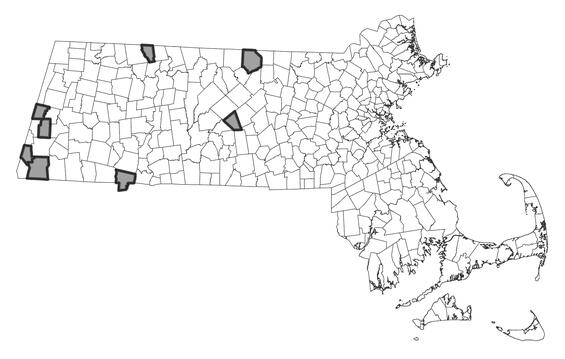- Scientific name: Eriophorum gracile
- Species of Greatest Conservation Need (MA State Wildlife Action Plan)
- Threatened (MA Endangered Species Act)
Description
Slender cottongrass, a narrow-stemmed, grass-like perennial in the sedge family (Cyperaceae), is topped by a cluster of white, bristly inflorescences that resemble tufts of wool when seen from a distance. In fact, the genus name comes from the Greek words erion and phorus, meaning "wool" and "bearing" respectively. The weak, unbranched, 2-6 dm (8-24 in) long stems are roughly circular in cross-section and rise from a creeping rhizome (underground horizontal stem).
Slender cottongrass' narrow blades are 1-2 mm (1/25-2/25 in) wide, and the uppermost is shorter than its sheath (the lower portion of a leaf that envelops the stem). There is one erect, foliaceous bract (modified leaf associated with an inflorescence) that is shorter than the inflorescence and, usually, blackish at its base. Cottongrass' wooly inflorescences occur as 2-5 spikelets (arrangements of reduced, stalkless flowers and bracts on an unbranched axis). Bristles are fully developed from early June to early July. The three-sided achenes (dry, one-seeded fruits) are brown and 2.5-3.5 mm (3/25-4/25 in) long.
Plants that may be mistaken for slender cottongrass include various other species of Eriophorum. Rough cotton-grass (E. tenellum) can be distinguished by its uppermost leaf, the blade of which equals or exceeds its sheath in length. Both tawny cotton-grass (E. virginicum) and fen cotton-grass (E. viridicarinatum) have two or three foliaceous bracts, in contrast to the one of slender cotton-grass. Finally, tussock cotton-grass (E. vaginatum) has only one spikelet and no foliaceous bracts.
Life cycle and behavior
This is a perennial sedge.
Population status
Slender cottongrass is listed under the Massachusetts Endangered Species Act as threatened. All listed species are protected from killing, collecting, possessing, or sale and from activities that would destroy habitat and thus directly or indirectly cause mortality or disrupt critical behaviors. The Natural Heritage and Endangered Species Program documents eleven current (1985-2010) occurrences and nineteen historical sites where the species is no longer found. One reason for its rarity in Massachusetts is because it is near the southern edge of its range. It is considered rare in many of the states on the southern edge of its distribution. Globally, Nature Serve ranks slender cottongrass as G5, secure.
Distribution and abundance
Slender cottongrass is a circumboreal species. In North America, the documented range of slender cottongrass extends from Newfoundland to British Columbia, south to Pennsylvania, Indiana, Iowa, Colorado and California.

Distribution in Massachusetts. 1999-2024. Based on records in the Natural Heritage Database.
Habitat
Slender cottongrass is a plant of swamps and peatlands. Habitats in Massachusetts include acidic and calcareous fens (peatlands that receive nutrients from groundwater) and portions of seepage swamps. Regularly associated species include. Regularly associated species include leatherleaf (Chamaedaphne calyculata), multiple species of sedges (Carex spp.), and three-way sedge (Dulichium arundinaceum) growing on sphagnum moss, often with nearby broad-leaved cattails (Typha latifolia) and other species of marshes. In calcareous sites, regular associates include shrubby cinquefoil (Dasiphora floribunda).
Healthy habitats are vital for supporting native wildlife and plants. Explore habitats and learn about conservation and restoration in Massachusetts.
Threats
Declining water levels and degradation of water quality are primary threats to this species.
Conservation
Peatland species such as slender cottongrass depend on the sites receiving water of consistent quantity and quality. Degradation or interruption of water supplies could lead to habitat degradation, threatening the species. Competition from non-native invasive species can be a threat through shading and loss of space for native species. Monitoring and removal of competing vegetation should be considered as a management strategy where appropriate. All active management of rare plant populations (including invasive species removal) is subject to review under the Massachusetts Endangered Species Act and should be planned in close consultation with MassWildlife’s Natural Heritage & Endangered Species Program.
Contact
| Date published: | May 7, 2025 |
|---|